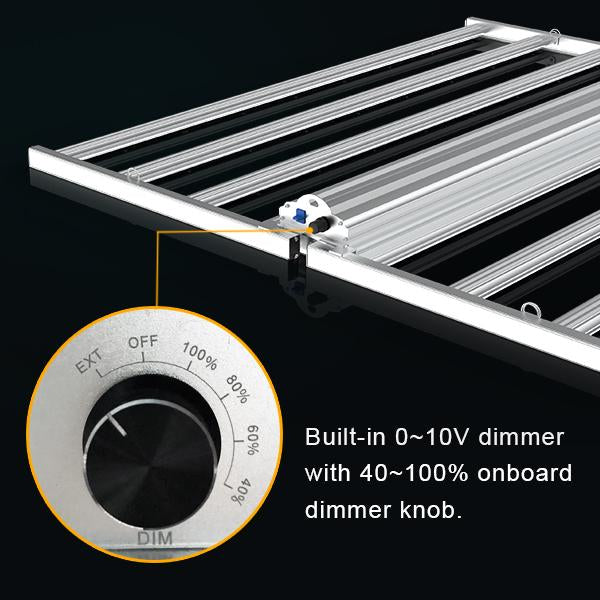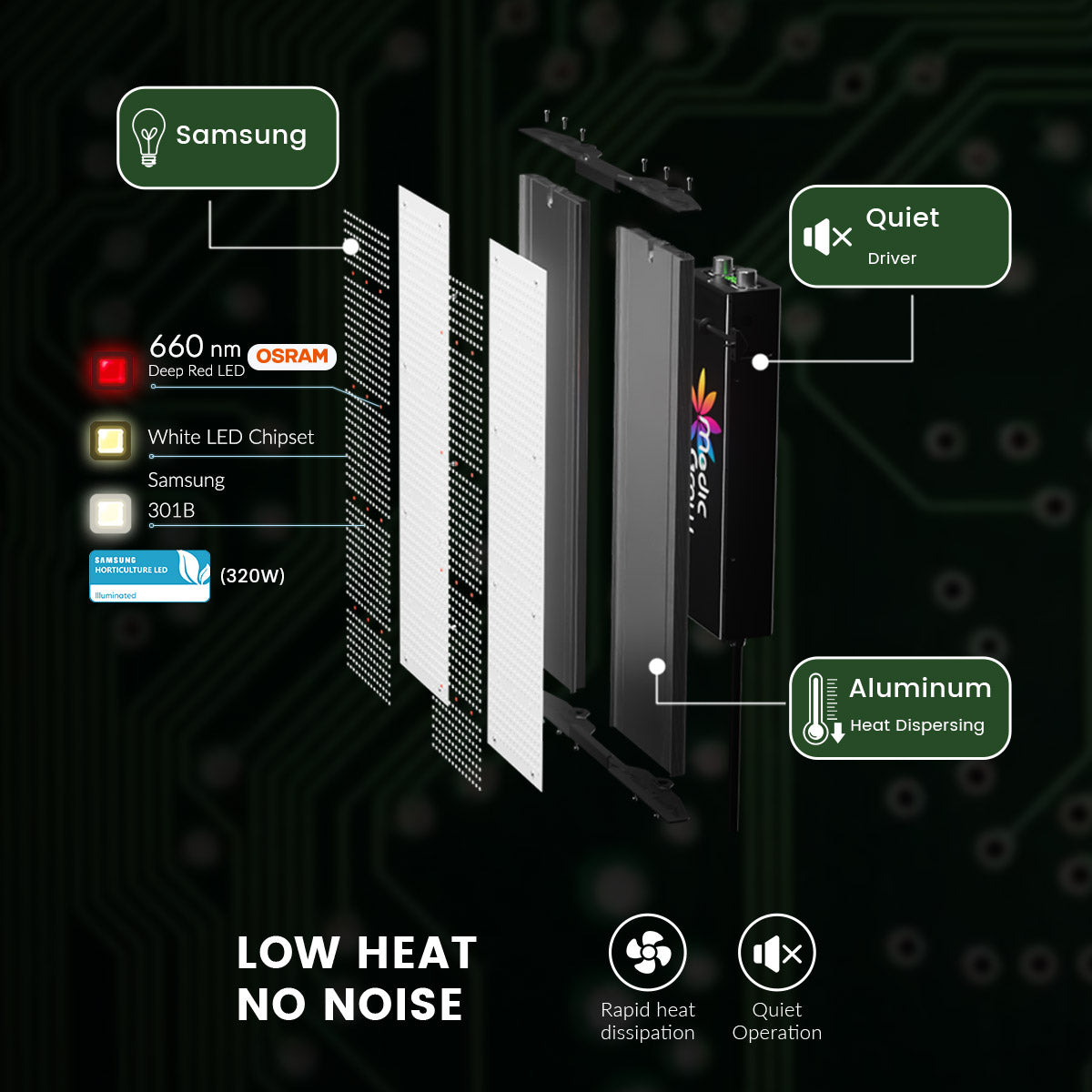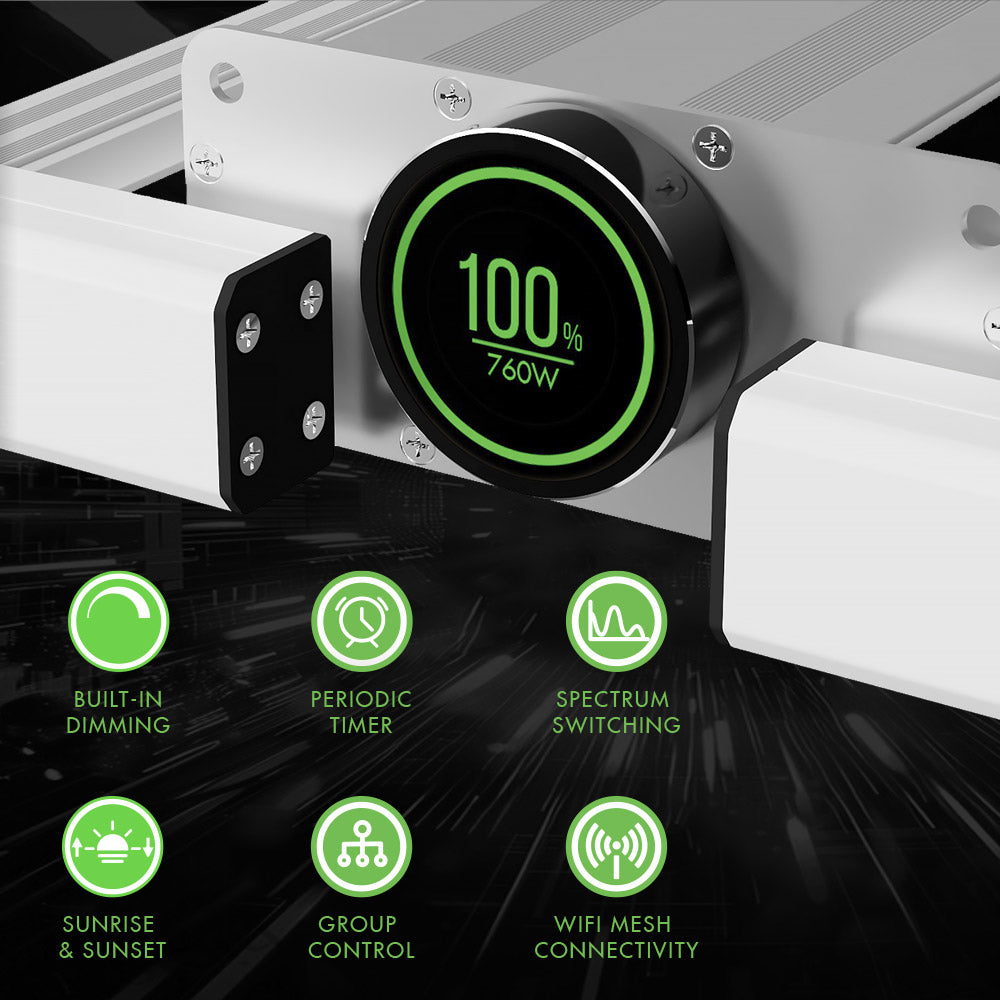
How Much Light Do Indoor Plants Need?
Grow Light is a necessity for plants, especially indoor plants because it acts as a catalyst in photosynthesis, and without it, the reaction is not possible.
There is no doubt that light plays an important role, but we cannot provide light to the plants the whole day.
It is important to control light as different types of indoor plants have different light requirements. For optimal results, you need to take care of it.
In this article, we will discuss how much light your indoor plants need. We will try to explain every aspect in detail. Let’s begin.
- Part 1: Signs of Too Much or Too Little Light
- Part 2: Light Measurement for Indoor Plants: PAR or Lumens?
- Part 3: Know How Much Light Your Specific Plant Need
- Part 4: How to Get the Optimum Indoor Light
- Part 5: Growing House Plants with Artificial Light
Signs of Too Much or Too Little Light
Both too much and too little light are unfavorable for plants. Whether the plants are in your backyard or inside your house (indoor plants), it is important to ensure that plants are receiving the right amount of light they need.
When plants receive too much or too little light, they show some signs.
For a plant grower, it is important to keep an eye on these signs and act accordingly before anything worse happens.
Signs of Too Little Light
For indoor growers, this problem is quite common. The indoor plants are often deprived of the light they need.
There are some symptoms and signs that can indicate your plant needs more light.
If you see one or more of these signs, you must increase the light exposure.
1) Change in Color
The first thing that the grower can notice is the color of the leaves.
The leaves are green due to the presence of a green pigment called chlorophyll. This green pigment appears green as it absorbs all colors except green, which is why it gives off the green light.
Chlorophyll is present in the chloroplast. It has the utmost importance as photosynthesis takes place because of it.

Image Source: flowvella.com
Without the process of photosynthesis, plants cannot produce their food.
We all know that plants need light to carry out photosynthesis. If the plant is receiving low light, then the process of photosynthesis will be slow, and the plant will not be able to produce sufficient food.
Due to scarcity of food/energy, the plant cannot produce green pigment (chlorophyll). Consequently, there will be a change in the color of the leaves.
Finally, the green leaves will turn pale green. If the scarcity continues, it will change to yellow and then white.

In the case of variegated plants, the change of color is a bit different.
As they are normally white (can be another color like pink), their original color is the sign they are receiving the right amount of light.

If the color of their leaves turns green, then they are receiving little light. It is because they are deprived of energy, and they try to get more energy by increasing the amount of chlorophyll in the leaves.
2) Leggy Stems
When plants do not receive enough light to produce energy and food, they cannot make new leaves. In this case, only the stem grows using the available energy/food.
The stem becomes leggy, and there are fewer leaves on it. It means there will be more spacing between the leaf nodes and leaves.

If you notice that the spacing between the nodes is increased and the plant is becoming thin and long, you should increase the light.
3) Wet Soil
Wet soil is another sign of too little light. Plants need light and water to make their own food. They absorb water from the soil and convert it to energy by reacting it with carbon dioxide in the presence of light.
If there is little light, the plant cannot carry out photosynthesis. Consequently, it does not use water in the soil, and the soil remains wet for a long time.
If you notice the soil remains wet longer than usual, your indoor plants need more light.
5) No Flowering
If you have indoor flowering plants, then they won’t give you flowers in the case of low light. It is because the plant does not have enough energy to produce flower buds.
Thus, if you have noticed fewer or no flowering, you need to check the light level.
6) Leaf Fall
The leaves on the plants may fall if they are not getting enough light.
The chlorophyll in the leaves assists in photosynthesis, but when the light is lower than the requirement, the plant cannot produce food.
The leaves may fall from the plant as they cannot get enough energy to survive. In normal cases, the leaves fall from the plant at a certain age, but if you notice something unusual, it is a sign of too little light.

7) Bending/Leading Towards Light
It is noticed that the plant bends towards the light source if it is receiving too little light. It is difficult to notice this sign, but you will also see other signs with it.
8) Smaller Leaf Size
Every plant has a tendency to grow a certain size of leaves. In the case of low light, the plant is deprived of energy, and the size of the leaves becomes shorter.
You will start noticing this sign if the plant has been receiving too little light for a long time.
Signs of Too Much Light
Too much light also imposes a bad impact on plants. It can kill your plant, and most of the time, it makes it dry, and the plant cannot carry out photosynthesis. There are only a few signs to detect this issue in plants.
1) Fading in Color
The color of the leaves will fade with time, and if this issue persists for a long time, you will see bleached leaves.

This is a clear indication your plant is receiving too much light. The leaf or a part of the leaf might also get burned or scorched.
2) Lesser Life of Flowers
In the case of too much light, the flowers will not live a longer life. You will first notice the contraction in flowers, and then they will die soon.
3) Wilted Leaves
Due to excess heat and light, the leaves bend and become limp. This is also known as leaf drooping.
Light Measurement for Indoor Plants: PAR or Lumens?
For indoor plants, we need grow lights to mimic the sunlight. These lights have utmost importance as they are responsible for the growth of plants by providing the required spectrum of light.
Thus, you need to purchase grow lights with care.
While buying a grow light for indoor plants, the most important thing that comes to mind is the output of the light. A grow light is evaluated on the basis of its output.
You will see PAR, lumens, or both on the specification, and this is where beginners get confused.

Image Source: oio-7.top
It is important to understand PAR and Lumens to determine whether the grow light is suitable for your plant or not.
Lumen is the SI unit of luminous flux. It is actually for humans because it is related to the light perceived by the human eye.
Our eyes can only see the visible range of white light, which is 400-700 nm in wavelength. However, the white light also contains other radiations, including UV and IR.
Lumen specifies the range of the light that humans can see. It does not tell what plants perceive.

Image Source: viewsonic.com
For plants, there is a special unit, which is PAR. It is an acronym for Photosynthetic Active Radiation. It represents the light/radiations that plants use for photosynthesis.
The spectrum of light that we see through the common eye is a bit different than what plants need. We see almost all radiations playing an equal role in the spectrum.
In contrast, plants do not use all radiations in the spectrum equally.
For instance, the least useful radiation for plants is yellow, while humans have a great impact of yellow radiation on eyes. Moreover, blue light is the most fruitful light for plants.

Image Source: oio-7.top
It is clear that PAR and Lumens are different. PAR is for plants, and Lumens is for humans.
Thus, while selecting the grow lights for indoor plants, you need to consider the PAR value.
Usually, both values are mentioned in the specification, but PAR has more importance. You need to select the light that has a suitable PAR according to your indoor plants.
PAR is mearsured in PPF (Photosynthetic Photon Flux) that quantifies the number of plant-usable photons emitted by a light source.
Its unit is µmol/s (micromoles per second), and you will find this value in the specification of authentic grow lights.
You might also encounter another metric, which is PPFD. It is a Photosynthetic Photon Flux Density that represents PPF per unit area. This also helps in understanding how much the PPF the grow light fixture can provide in a unit area. Its unit is µmol/s/m2 (micromoles per second per square meter).
Know How Much Light Your Specific Plant Need
Different plants need different intensities of light. Some are low light indoor plants, some are medium light indoor plants, and the remaining are bright light indoor plants.
They need the required intensity to grow and offer fruitful results. Therefore, indoor growers need to understand how much light their indoor plants need.
Before we dive into the types of plants that require low, medium, and bright light, we need to understand what low, medium, and bright light are.
Low Light: Low light is said when there is no direct sunlight.
The plant remains away from the natural sunlight, and inside the indoor grow room, it is away from the grow light. This could be achieved by a small fixture of 10-50 watts, and the PPFD can be 50-150 µmol/s/m2.
Medium Light: Medium-light also means no direct sunlight, and the distance between the light fixture and plant is a bit less than the previous case (low light). The PPFD for this light ranges from 150 µmol/s/m2 to 250 µmol/s/m2.
Bright Light: Bright light refers to direct sunlight. It is also called High Light. The light fixture, in this case, is quite near to the indoor plants. The PPFD is around 250-450 µmol/s/m2.
Now, let’s have a look at the types of different indoor plants.
Low Light Indoor Plants
There is a wide range of low light indoor plants, but some of them are,
- Aspidistra Elatior (Cast Iron Plant)
- Peace Lily
- Lucky Bamboo
- Mass Cane (Dracaena Massangeana)
- Pothos
- ZZ Plant
- Sansevieria
- Aglaonema (Chinese Evergreen)
Medium Light Indoor Plants
- Alocasia
- Anthurium (Flamingo Lily)
- Astrid Pep
- Soleirolia Soleirolii
- Bamboo Palm
- Never Plant
- Danish Ivy
- Kentia Palm
- Neanthe Bella
- Spider Plant
Bright Light Indoor Plants
- Yucca Plant
- Pony Tail Palm Tree
- Ti Plant
- Orchids
- Gardenia
- Jasmine
- Dwarf Umbrella Tree
How to Get the Optimum Indoor Light
We have already discussed how important it is to give optimum light to plants. Its excess and scarcity can lead to unfavorable conditions.
There are three things that you need to keep in mind to give optimum light to your plants. Those three important factors are,
- Light Spectrum
- Light Intensity
- Light Amount
They are factors that determine whether the light provided to your plants is perfect or not. Whether you want to control the light or evaluate it, you need to consider these factors.
Let’s have a look at them.
1) Light Spectrum
The sunlight contains various electromagnetic radiations, including the complete visible spectrum (colors of the rainbow), Ultraviolet (UV), and Infrared (IR).
Thus, the sunlight has a complete spectrum of radiations.
The grow lights that we use for growing plants mimic the sunlight. They provide electromagnetic radiations and the desired spectrum to the plants so that they can carry out photosynthesis.

Image Source: darkniteglow.com/
Different types of indoor plants and growth stages require a different spectrum of light. For instance, red light bulbs are suitable for flowering and the formation of new buds. You need to fulfill the requirements to get optimum results.
Modern LED grow lights for indoor plants, such as Spectrum X, offer various spectrums. You can select the desired spectrum according to the growth stage and plants.

2) Light Intensity (how strong the light is)
Another important thing is the intensity of the light.
You can consider it as the brightness level that falls on the plants.
We know that if the intensity of the light is too much, it will burn the leaves. In the case of low intensity, there will be other issues, and you won’t get the desired results.
The intensity depends on the distance between the light fixture and house plants. If the light is far, the intensity will be low, and if it is near, the intensity will be high.
It also depends on the type of indoor plants you have.
For instance, the plants that grow in forests do not need a high intensity. On the other hand, flowering plants and vegetable plants require high intensity.
Thus, you need to adjust the intensity according to the indoor plants.
Moreover, intensity is also given according to the growth stage of indoor plants. If you have just sowed the seeds, then it requires high intensity.
In simple lights, such as common CFL, you can change the distance or number of lights to control the intensity.
But in modern indoor grow lights for plants, there is usually a controller you can use to control the brightness of the LED.
For instance, Fold 800W LED grow lights have a knob to control the intensity.

3) Light Amount (how many hours)
You cannot leave your plants under light all day. They also need to take some rest. Plants need light for a specific duration.
According to the amount of light, indoor plants can be classified into three types.
- Short-day Plants: Plants that need light less than 12 hours per day.
- Long-day Plants: Plants that need light for 14 to 18 hours per day.
- Day-neutral Plants: Plants that need light for 8 to 12 hours per day.
You need to know how many hours your indoor plants need light. Then, you need to provide lighting according to that. The duration of light also depends on the growth stage of plants.
Growing House Plants with Artificial Light
Plants need light to carry on photosynthesis and produce their own food/energy. The only way to provide light to indoor plants is by using an artificial light source, and this is where grow lights play their role.
Grow lights mimic the sunlight and provide the light that indoor plants need.
Plants can grow in artificial light, and it is better than outdoor growing as you can control the intensity, duration, and spectrum of light by using the required grow light according to your plants. This maximizes the yield and offers excellent results.
There are different types of grow lights in the market, such as LED grow lights, fluorescent lights, and HIDs. These lights are used according to the budget of the indoor grower and the plants he wants to grow.
Full-spectrum LED grow lights are the most efficient and useful for indoor plants. Whether you have a small grow room or a commercial grow room, you can use these lights.
The important thing about LED grow lights is that they are 80-90% efficient, and it is getting better with the advancement in technology.
These lights have a lifespan of over 15 years, and the electricity consumption is quite reasonable due to high efficiency. In the long run, indoor growers get many benefits from LED grow lights.
But keep in mind that these lights are expensive.

Modern LED grow lights are equipped with many features and controllers that provide optimal results.
In common grow lights, you need to adjust the distance between the light and the plant, but in modern LED lights, you can adjust the brightness according to your needs.
All you need is to turn the knob and set the desired level of brightness. It means you can easily control the intensity without any hassle and give the required light to the plants.
If your LED grow light does not have a brightness controller, you need to adjust its height. However, height adjustment is also easy as the lights have adjustable hanging strings.
Another important thing about LED grow lights is their different spectrums.
For instance, Spectrum X and Spectrum Y UV light for plants provide four types of spectrums, including V1, F1, VS, and FS. You can select any spectrum according to the plant or growth stage. They can also provide UV and IR radiation to plants for better growth.
Simply put, LED grow lights are perfect for indoor growers. They can grow plants at optimal conditions in order to achieve excellence and more yield.
Related Posts
Are LED Grow Lights Harmful to Humans?
Featured Products
Blog Posts
Contact Us with Any Idea!
- Choosing a selection results in a full page refresh.
!
































